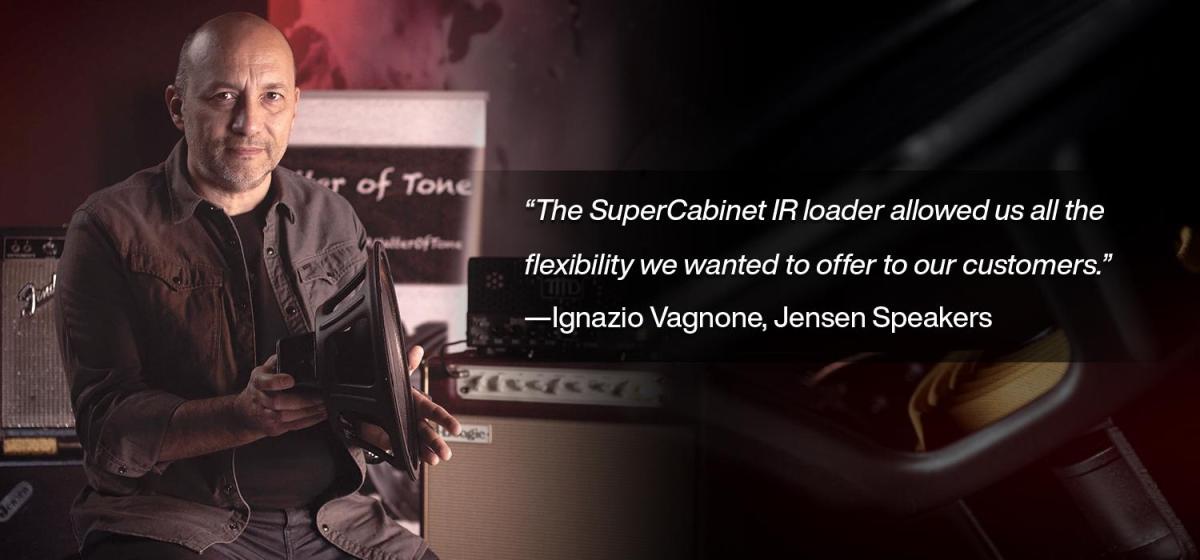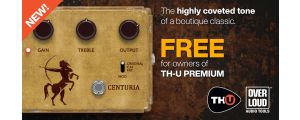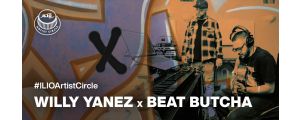Jensen Loudspeakers have been thumping in legendary guitar cabinets for decades, and have made an indelible imprint on rock history. To mark the release of the complete Jensen Original Collection for Overloud’s SuperCabinet, we revisited our interview with Jensen’s Ignazio Vagnone. We have added a few new questions on the newest releases to the top of this article.
Ignazio worked in collaboration with the team at Overloud to develop these excellent Jensen libraries. Calling on his expertise in recording and speaker technology, along with his strong historical perspective, Ignazio and the team built collections of IRs (speaker Impulse Responses) that reflect the fantastic heritage and ongoing prestige of the Jensen sound.
NEW—Congrats on releasing the additional new IR libraries for SuperCabinet. What should we know about this selection of IRs?
Thank you! We are very happy this is the final release that completes the Jensen Original Collection. Now we can say that every Jensen Speaker, from the AlNiCo speakers of the ‘50s, to the Ceramic speakers of the ‘60s, to the contemporary speakers of the Jet series, now has its digital twin. This was the goal we always had very clear in our minds. Vintage speakers are becoming increasingly rare, expensive, and really hard to find in good and original working order. We wanted to make these tones available to a whole new generation of players who never have had the opportunity to play them.
“The SuperCabinet is a unique ecosystem. It is the only available IR loader that allows easy navigation in such a wide database, alongside an unmatched level of editing, mixing and sheer creativity for the user.”
The complete collection is a gigantic work. Altogether, it is more than 31,000 IRs, from 31 individual speakers, picked up in 77 cabinets. This whole project makes sense only because of the cooperation with Overloud. The SuperCabinet is a unique ecosystem. It is the only available IR loader that allows easy navigation in such a wide database, alongside an unmatched level of editing, mixing and sheer creativity for the user.
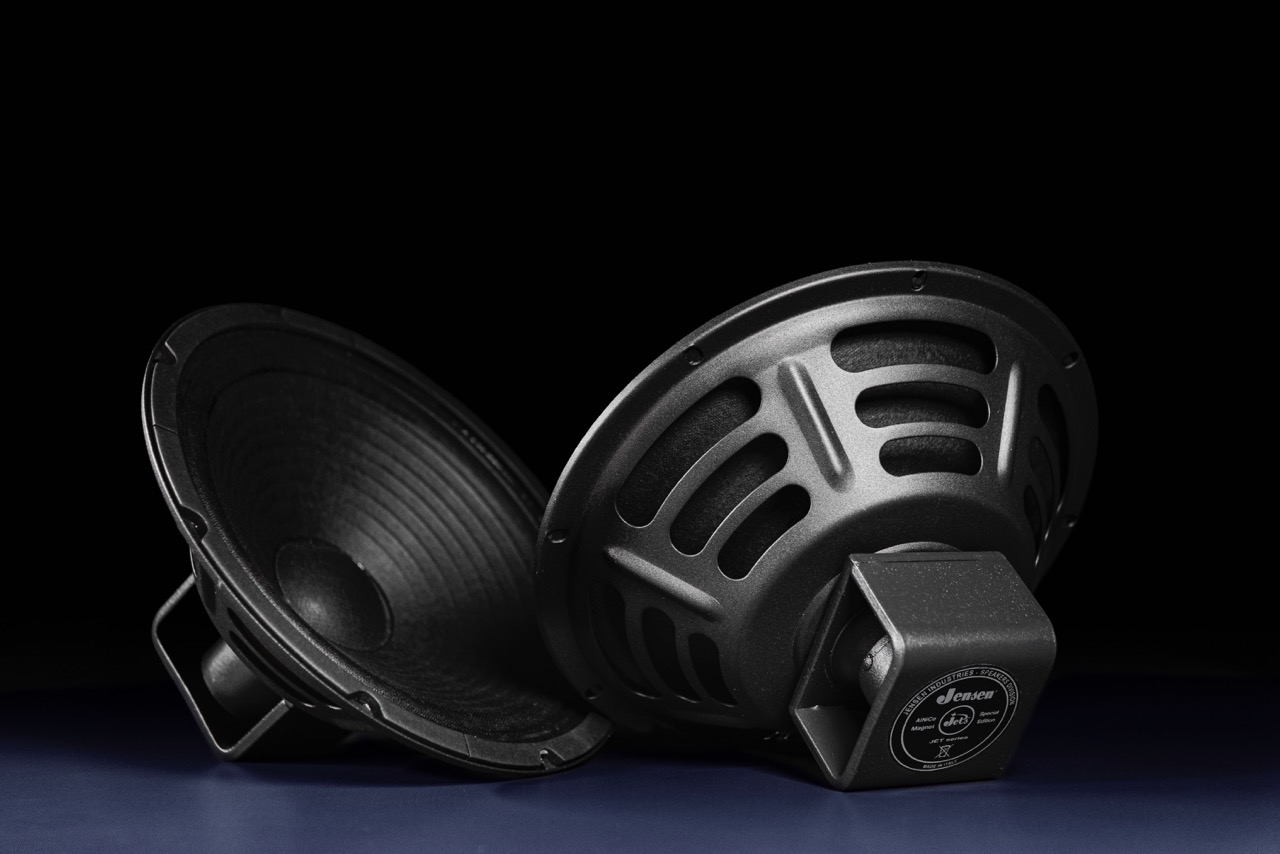
There are some very interesting speakers in this batch: the first is the new Blackbird 10-40, which we launched at the same time in its physical and digital versions. It’s a very important speaker for Jensen because it has been immediately adopted by Mesa/Boogie. I’d like to mention the P10R-F, a unique version of the classic P10R, developed with Fender for two of their Custom Shop Amps, the ’57 Tweed Bandmaster and the 25th Anniversary VibroKing. And finally, you must try the P12Q! It is one of the best-sounding vintage AlNiCo speakers we have. This speaker is used today by Supro, for its Black Magick amp, and by Mitch Colby in his Sundragon Amp. The Sundragon is a hand-built replica of Jimmy Page’s heavily modded Supro Coronado, the amp used to record the first Led Zeppelin albums… So, there’s a lot of fun built into these libraries!
NEW—The new Jensen Blackbird 10-40 speaker has been adopted by Mesa for their new California Tweed 2:20 range. What makes this speaker perfect for this new line of amps?
It all happened in a very natural, organic manner. Mesa initially adopted the Blackbird 100 for the original California Tweed 4:40. The BB12-100 has a rich, unique blend of smoothness, punch, evenness and top-end harmonics. It also has this relaxed, mature, rich and complex tonal spectrum. But when we developed the new Blackbird 12-40, Mesa loved it immediately for its tight, responsive, but open dynamic response. Paired with the Tweed-style amp design, it somehow felt more “vintage inspired.” The new BB12-40 was equally appealing yet with a different unique flavor… so, after some time, they changed the stock speaker for the Cali Tweed range from the BB12-100 to the BB12-40.

The feedback we got from our industrial customers, our boutique builders, down to our end-users has been unanimous: The BB12-40 is something special. The market, beginning with Mesa, immediately started demanding a 10” version. So we started the development, aiming to keep the components that are critical for the tonal balance untouched: the voice coil, the spider, the Reinforced AlNiCo magnet are the same as the BB12-40. Finding and optimizing the correct cone membrane took the longest time. We wanted to preserve the voicing in the midrange and treble range, and we wanted slightly softer, warmer dynamic behavior in the bass range because we knew that the 10” version was bound to be installed in smaller cabinet enclosures. Having more compliance and less stiffness helped to compensate the slightly inferior bass response of a smaller cabinet.
So, we tried to scale down the “magic” of the BB12-40 in its 10” sibling. Why does it fit so well with the Cali Tweed circuit? Because Tweed-style circuits are in general midrange focused, pretty gainy and somehow also pretty gnarly. The slightly scooped midrange of the BB40 helps tame this. The AlNiCo magnet gives its classic, nice shimmer on the top end. Being reinforced (30% stronger than an equivalent “normal” AlNiCo magnet) offers more control and tightness in the low end for an improved string definition. In a nutshell, our idea of a vintage voiced AlNiCo speaker, updated to today’s standard, aligned with their requirements in terms of tone and power handling.
NEW—What other libraries in the new Overloud SuperCabinet release are you the most excited about?
Hah, it’s hard for us to cherrypick the ones we like most. Maybe some are more “special” than others, for different reasons. We obviously love the Vintage Series, because they are the reason why Jensen is back in the industry. It is because of their success that we have been able to develop our new original designs, grouped in the Jensen JET series.
Among the Jet Series, The Raptor deserves some special attention. It is a truly versatile design, that fits in many different cabs, and performs greatly with such a wide variety of tones. The Blackbird 12-100 is just top class tone, silky smooth yet detailed, with deep, fat bass, and a vocal, rounded midrange. Almost impossible to pull a bad tone out of it. The Tornado series with the 100, the 80 and the 65 models, is one of the most successful Neodymium families on the market. Each model has its specific voicing and target application, starting with our best-seller: the Tornado 100.
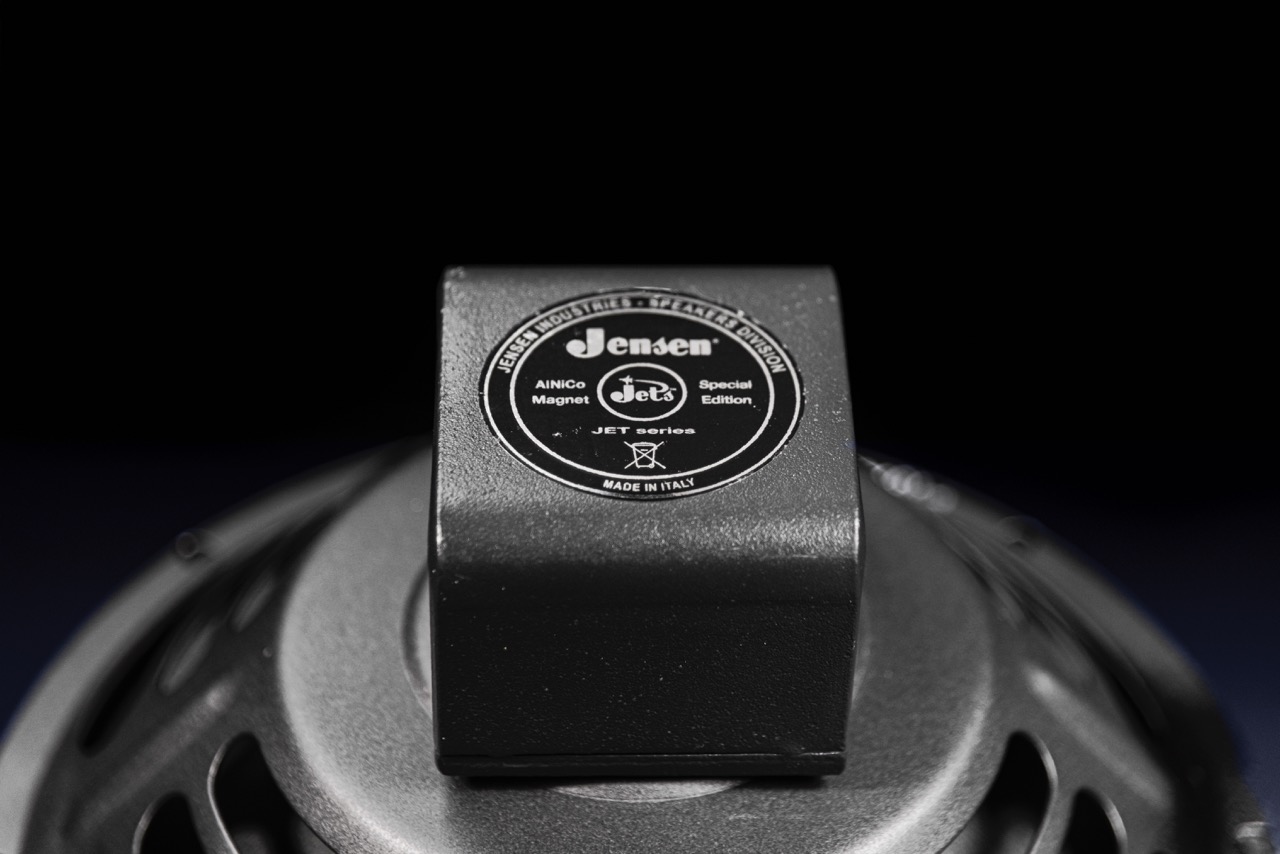
On the most contemporary side, ceramic speakers like the Nighthawk and the Electric Lightning, and by the same token, the Tornado 65 and the Tornado 80, powered by our exclusive 2nd Generation Neodymium magnets, are a strong statement for us, a step in a tonal family that Jensen never approached before the 2000s. These are the first generation of Jensen speakers designed and optimized for the hard rock and heavy metal scene.
Therefore, maybe the libraries of the Jet Series are the ones that we care the most about!
NEW—Anything to look forward to for future releases from the Jensen and Overloud collaboration?
First of all, we are really, really happy about the collaboration with Overloud. Working with them is easy, exciting and productive, the personal relationship is excellent, and there is always something new to mutually learn from each other.
We plan to develop our new speakers for the years to come, in “parallel” with Overloud. Of course, any new Jensen speaker that will be launched in the near future will have its digital counterpart by Overloud, possibly released at the same time in the market. In this regard, there will be some hot news in the next months. We have a medium-term product release plan that will keep both teams pretty busy!
“For how much the guitar speaker technology is rooted on principles and processes that are decades old, why shouldn’t we look forward and innovate?
But this is only the beginning. We are considering how to possibly integrate some of Overloud’s proprietary technologies in the R&D process of the new generations of Jensen Speakers. Until now, the manufacturers released a physical product, and then the software developers worked on it to capture its tonal imprint. What if we could reverse or at least integrate these two processes? What if we could digitally model the effect of a change of one or more parts on a speaker’s response? What if we could make “digital prototypes” of a speaker, before committing to a physical one? It’s a fascinating scenario that we’re starting to look at right now. For how much the guitar speaker technology is rooted on principles and processes that are decades old, why shouldn’t we look forward and innovate? Why not keep true to our heritage and at the same time offer new and advanced solutions?
Can you briefly outline the history of Jensen speakers as used in vintage gear all the way through modern rigs?
Jensen has been one of the primary suppliers to the American amp builders since the beginning of this industry. The vaste majority of the Fender amps - among many others - used the Alnico series until the early ‘60s. Let’s say, all the Fender Tweed, and most of Blonde and Brown amps used AlniCo speakers. Then nearly every manufacturer moved on to the Ceramic speakers, that became synonymous with the Black panel amps. In the late 60’s Jensen progressively lost interest in the guitar amplification market, and finally pulled out of it.
When Jensen was reborn, in the late ‘90s, the obvious starting point were the AlNiCo and Ceramic speakers of the Vintage series. In that period we started developing new and original speakers in the Jet series, oriented to both vintage and modern tones, up to high gain applications. Currently we work with many builders, from global brands to high-end boutiques, and they all use different speakers in our line-up… From Fender to Mesa, Supro, Magnatone, Harmony, Mad Professor, Koch, Dennis Cornell, Carr, among many others!
For readers who may not understand what speaker IRs are about, or even the importance of speaker/cabinet/amp combinations, can you explain how these combinations influence the the player's tone?
This is an important question. A guitar speaker has a very complex frequency response rich with resonances, and filled with peaks and dips. No traditional EQ is remotely capable of drawing a comparable curve, and that is why IRs are a crucial tool. In very general terms a guitar speaker covers a limited range, roughly from 70Hz to 7kHz, and in many cases shows a pronounced “presence peak” from 2 to 5kHz. This behavior generates the tone we associate with most of the guitar tracks recorded in the last six decades. Moreover, these speakers are designed for the maximum efficiency, therefore have very light membranes. This factor contributes to the generation of a complex, rich harmonic spectrum – call it “harmonic distortion” if you like! – even with just a few applied watts of power.

Basically, the design of a guitar speaker is all about shaping the tone and controlling the harmonics as per the designer’s target. As a matter of fact, the guitar speaker is by far the most complex and powerful filter applied to the guitar tone. And since it comes last in the signal flow, its effect directly reaches your ears – or the microphone. The enclosure also plays an important role. Shape, size, materials and acoustic design of the cabinet are all influential.
“All in all, the tone of a guitar cabinet is a complex system, as the sum of many interacting factors.”
Can you outline your capturing process for these new Jensen IRs, and how you arrived at creating the “digital version of the physical speaker”?
We started by selecting the most appropriate cabinet(s) for each speaker. As mentioned, the cabinet is crucial and a wrong matching may lead to unexpected results. As an example, the Vintage AlNiCo speakers were designed in the ‘50s for low to medium powered amps with quite resonant open back cabinets and a thin floating speaker baffle. We used (and even built) era-correct cabinets to host these speakers to sound in the way they were designed for. Same for the Vintage Ceramic of the ‘60s, and for the modern Jet series speakers as well. All have been individually installed in dedicated and appropriate enclosures.
“We went a long way in playing, listening and comparing the physical speakers and their digital versions through the same sets of mics and monitoring systems, to make sure the IRs mirrored the originals in the most realistic way.”
How would you rate the Jensen IRs versus the physical speakers?

They are stunningly close. Almost identical. When you load the IR in TH-U of the P8R, an AlNiCo 8” speaker, you get that sense of grittiness and quick response. When you load a Raptor, one of the most powerful 12” in the line, you feel the headroom, the dynamic response and the clarity that you experience with the real one. We are very proud of the job done by our team, together with the Overloud wizards!
Can you highlight a few speakers you are excited about in the new IR lineup for High headroom cleans/metal (Mesa) sounds, and low headroom speakers that distort for vintage sounds?

Modern clean and high gain tones demand a speaker with a quite specific set of features: larger voice coils (1 ¾” or 2”), powerful magnets for a deep, tight, controlled bass range and a certain response in the mids and trebles. Our Nighthawk, Tornado, C12K2, Raptor and Electric Lightning are among the favorites for these applications.
On the contrary, vintage tones usually come out best with lower powered speakers, with smaller voice coils (from 1” to 1 ½”), smaller magnets and softer membranes. The P10R, P12Q, C12N are some of the most sought after for the vintage oriented players.
“ I’d like to mention the Blackbird 100 and the Blackbird 40, our top-of-the-line Jet Series AlNiCo speakers- these are two fantastic sounding models, very versatile with a high-class, very refined personality. They are my personal favorites!”
I see many of the new IRs are named after the materials used in speaker magnets. Can you explain how magnets affect the tone?
The magnet influences the tone in two main aspects: the tone and the dynamic behavior. Let’s consider three speakers that are perfectly identical, where the only difference is the magnetic material. The AlNiCo powered speaker will have a subtle dynamic compression that increases together with the volume. Additionally, the bass range may be slightly softer and looser. while the treble range will have a typical “chime” and openness. The Ceramic powered speaker will be stouter and more straightforward sounding, with little or no dynamic compression. The bass range will be firmer, with more midrange projection, and slightly subdued trebles. The Neodymimum powered speakers sit somewhere in the middle, but closer in behavior, tone and feel to an AlNiCo than to a Ceramic one. Therefore it’s a very versatile alternative with a nice sheeny character.
When loading a Jensen Speaker IR in TH-U, are there some general rules about selecting the mic placement (cap, cap edge, cone, cone edge) and mic type to best create specific tones?
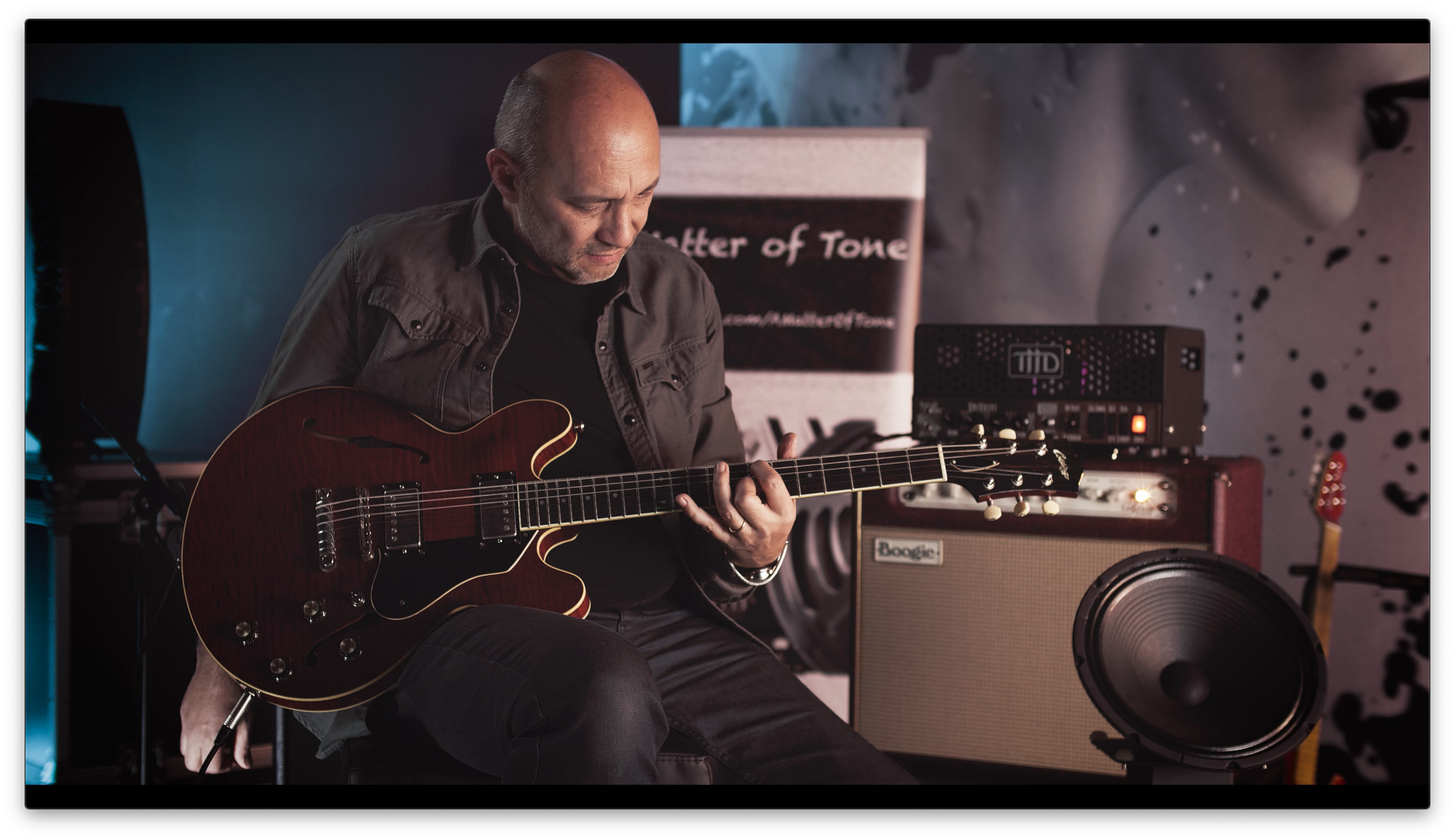
The technology in TH-U allows for the maximum flexibility without incurring in phasing issues. Therefore, the best rule is “there are no rules.” You, the player, have the maximum flexibility in experimenting to create your own tone. One of our favorite combinations for a rich, lush clean or low-gain tone is a carefully balanced mix of a dynamic mic (on axis, cap edge or cone), with a ribbon mic (on axis, cap or cap edge). With this micing you can capture a fuller, wider tone, giving depth and fullness to both rhythm and single note playing. For high gain tones, we usually recommend a tighter mic arrangement, maybe just with a single dynamic mic, cap edge, filtering out the lower bass and the upper treble. The nature of the lead tones is already quite thick in the lower midrange, and extremely rich in harmonics in the top end. This may be a good starting point for a focused and punchy overdriven tone.
What makes TH-U the perfect vehicle for the Jensen Speaker IRs?
First and foremost, Overloud’s heritage and experience in capturing. Since we started talking, we immediately realized that we shared a lot of common ground and experience. It was very easy to agree on the technical details of the capturing process, as we both aimed at the same target. Not only can you use some of the most iconic speaker/cab/mic arrangements, but you can also create totally unique and new IRs, by mixing, matching and filtering up to four libraries with the tools provided. The Super Cabinet also allows you to export your finely crafted IR to be used in your outboard, be it an amp with an IR loader or a multi-effect digital pedalboard, to have your tone wherever you go, with whatever gear you plan to play! This versatility is an incredible added value.
“The SuperCabinet IR loader allowed us all the flexibility we wanted to offer to our customers.”
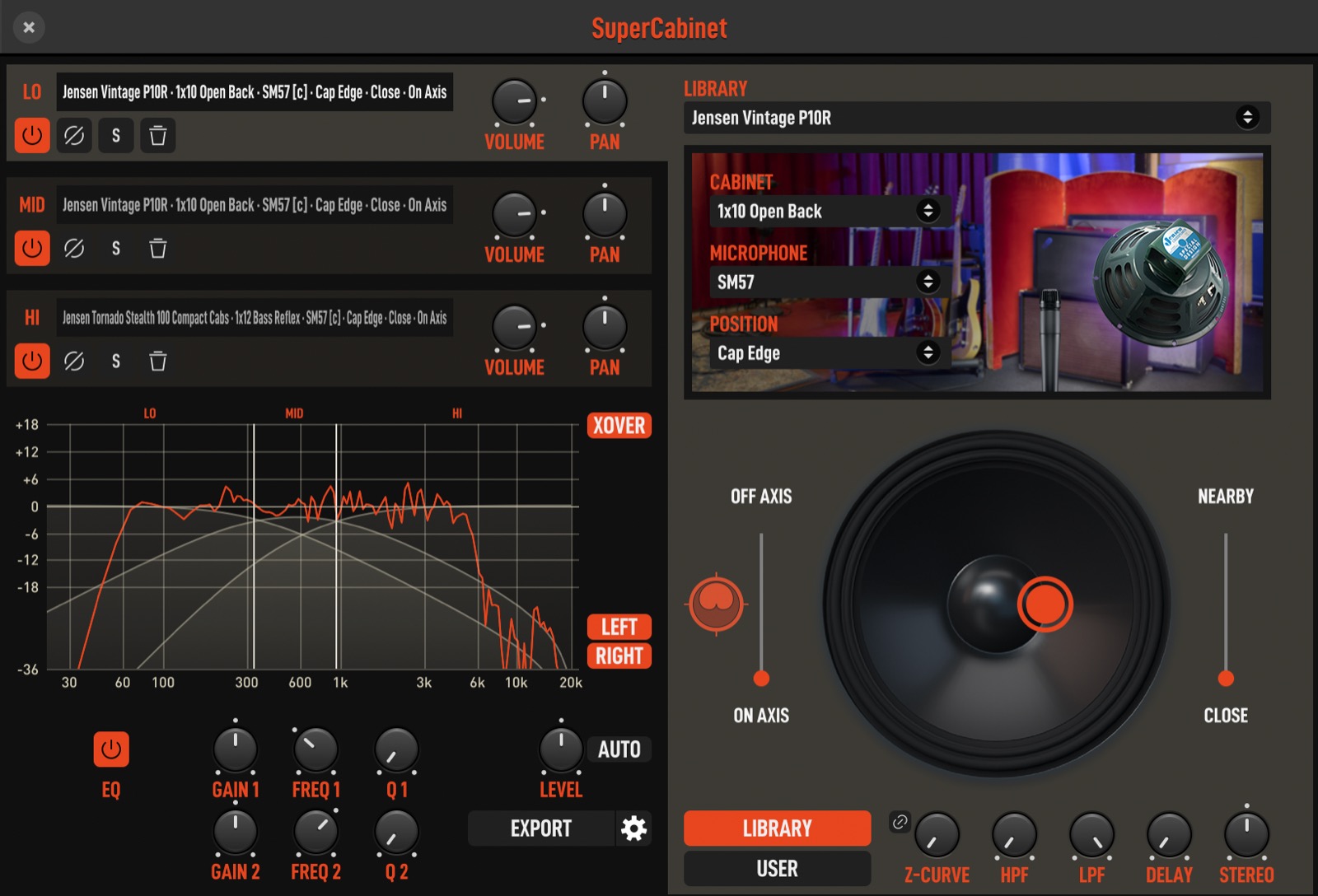
What sets Jensen apart from other speakers used to reproduce guitar tone?
Jensen Speakers’ history is split in two periods. The vintage era, when Jensen was one of the primary voices of this new-born, screaming baby named rock’n roll. There are thousands of artists and tracks recorded with those speakers spanning from seminal to the roots of American music. Then Jensen pulled out from the industry, to come back in the 2000s, not only reissuing the vintage speakers but also providing new original sounding speakers for the modern players using new materials, new technologies and new sound design approaches. The exclusive “Reinforced AlNiCo” magnet technology used in the Jensen Blackbird 40 is the perfect example of an innovative, creative idea developed for the benefit of the players. Innovation has been in our culture for more than a century. The dynamic speaker as we know it was actually invented by Peter Jensen in the 1910s.
“We keep on honing our heritage, and using it as a platform for more, newer generations of tone.”
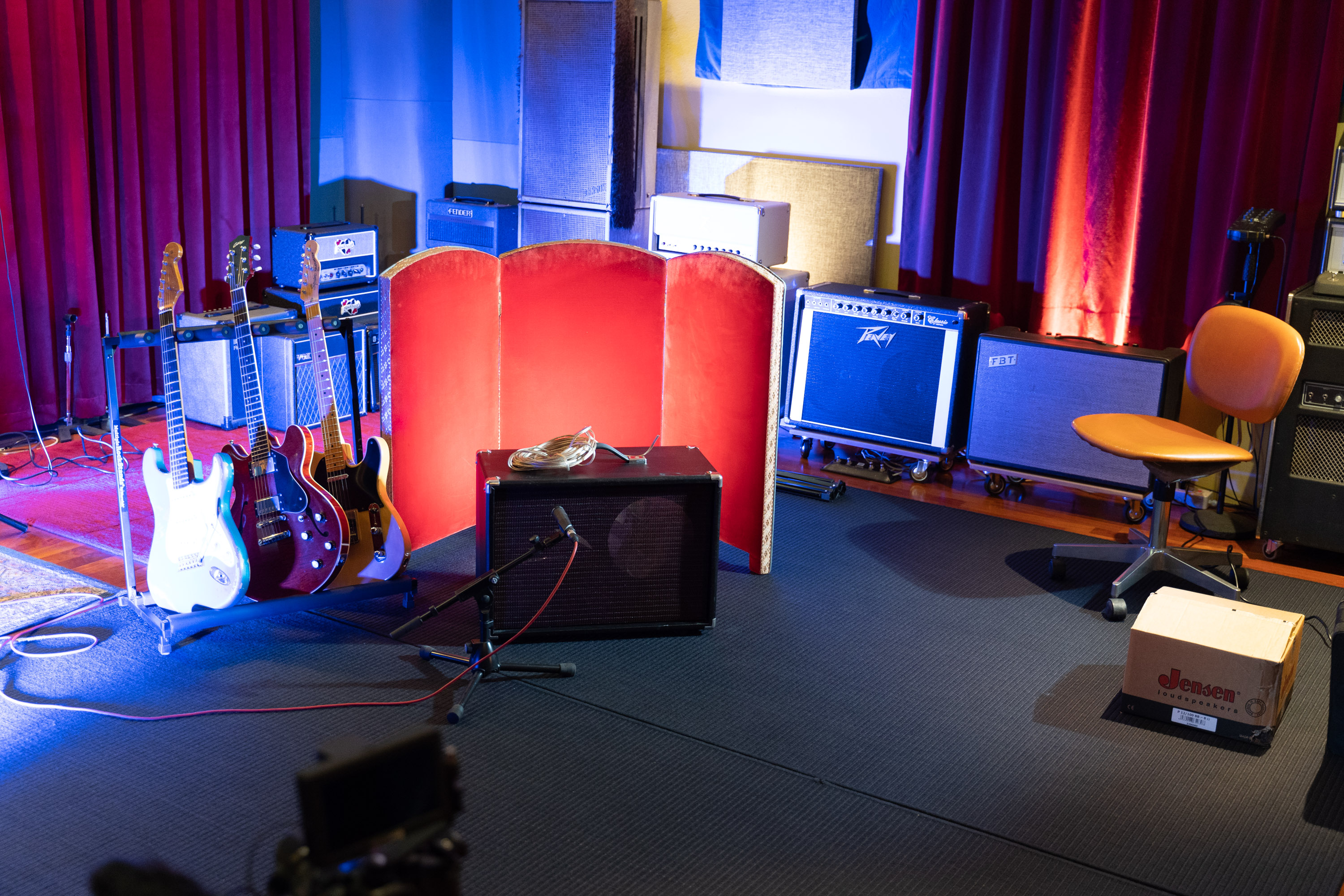
The studio used by engineers at Jensen and Overloud for capturing the IRs
What else should readers know about Jensen and the Jensen Speaker IRs in TH-U?
Jensen Speakers are designed and made in Italy, by SICA Altoparlanti. We live, eat and breathe speakers and nothing else. We’re a bit like TH-U by Overloud-purely Italian, totally focused and committed to excellence in tone. The Jensen SuperCabinet Libraries is just the first step in our cooperation. We have matured together in this process. We have already considered the foundation of a new project we’ll be developing together. We are aiming to join the two worlds even more closely of the physical and the digital versions of a guitar speaker… How will this happen? You’ll see in a while…

